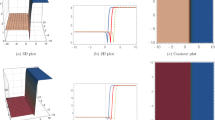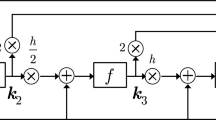Abstract
The cochlea is an indispensable preliminary processing stage in auditory perception that employs mechanical frequency-tuning and electrical transduction of incoming sound waves. Cochlear mechanical responses are shown to exhibit active nonlinear spatiotemporal response dynamics (e.g., otoacoustic emission). To model such phenomena, it is often necessary to incorporate cochlear fluid–membrane interactions. This results in both excessively high-order model formulations and computationally intensive solutions that limit their practical use in simulating the model and analyzing its response even for simple single-tone inputs. In order to address these limitations, the current work employs a control-theoretic framework to reformulate a nonlinear two-dimensional cochlear model into discrete state space models that are of considerably lower order (factor of 8) and are computationally much simpler (factor of 25). It is shown that the reformulated models enjoy sparse matrix structures which permit efficient numerical manipulations. Furthermore, the spatially discretized models are linearized and simplified using balanced transformation techniques to result in lower-order (nonlinear) realizations derived from the dominant Hankel singular values of the system dynamics. Accuracy and efficiency of the reduced-order reformulations are demonstrated under the response to two fixed tones, sweeping tones and, more generally, a brief speech signal. The corresponding responses are compared to those produced by the original model in both frequency and spatiotemporal domains. Although carried out on a specific instance of cochlear models, the introduced framework of control-theoretic model reduction could be applied to a wide class of models that address the micro- and macro-mechanical properties of the cochlea.

















Similar content being viewed by others
References
Antoulas AC (2005) Approximation of large-scale dynamical systems, vol 6. Society for Industrial Mathematics, Philadelphia
Baker GJ (2000) Pressure-feedforward and piezoelectric amplification models for the cochlea. Stanford University, Stanford
Bell A (2007) Tuning the cochlea: wave-mediated positive feedback between cells. Biol Cybern 96:421–438. doi:10.1007/s00422-006-0134-0
Bendor D, Wang X (2005) The neuronal representation of pitch in primate auditory cortex. Nature 436:1161–1165
Bertaccini D, Sisto R (2011) Fast numerical solution of nonlinear nonlocal cochlear models. J Comput Phys 230:2575–2587
Elliott SJ, Ku EM, Lineton B (2007) A state space model for cochlear mechanics. J Acoust Soc Am 122:2759
Eronen A, Klapuri (2000) A Musical instrument recognition using cepstral coefficients and temporal features. In: Acoustics, speech, and signal processing, 2000. ICASSP’00. Proceedings. 2000 IEEE international conference on, IEEE, vol 752, pp II753–II756
Gao SS et al (2014) Vibration of the organ of Corti within the cochlear apex in mice. J Neurophysiol. doi:10.1152/jn.00306.02014
Gugercin S, Antoulas AC (2004) A survey of model reduction by balanced truncation and some new results. Int J Control 77:748–766
Hasan MR, Jamil M, Rahman MGRMS (2004) Speaker identification using Mel frequency cepstral coefficients variations 1:4
Hassan E-S (1985) A suggested role for secondary flow in the stimulation of the cochlear hair cell. Biol Cybern 53:109–119. doi:10.1007/BF00337027
Hudspeth A (2008) Making an effort to listen: mechanical amplification in the ear. Neuron 59:530–545
Jahn AF, Santos-Sacchi J (2001) Physiology of the ear. Taylor & Francis, New York
Joosten ER, Neri P (2012) Human pitch detectors are tuned on a fine scale, but are perceptually accessed on a coarse scale. Biol Cybern 106:465–482
Kim Y, Xin J (2005) A two-dimensional nonlinear nonlocal feed-forward cochlear model and time domain computation of multitone interactions. Multiscale Model Simul 4:664–690
Lamar A, Todd, Gonzalez O (2005) Human acoustics: from vocal chords to inner ear
LaMar MD, Xin J, Qi Y (2006) Signal processing of acoustic signals in the time domain with an active nonlinear nonlocal cochlear model. Signal Process 86:360–374
Large EW (2010) Neurodynamics of music music perception. 201–231
Large EW, Almonte FV, Velasco MJ (2010) A canonical model for gradient frequency neural networks. Phys D Nonlinear Phenom 239:905–911
Lee HY, Raphael PD, Park J, Ellerbee AK, Applegate BE, Oghalai JS (2015) Noninvasive in vivo imaging reveals differences between tectorial membrane and basilar membrane traveling waves in the mouse cochlea. Proc Natl Acad Sci 112:3128–3133
Logan B (2000) Mel frequency cepstral coefficients for music modeling. In: International symposium on music information retrieval, p 5
Mammano F (1990) Modeling auditory system nonlinearities through Volterra series. Biol Cybern 63:307–313. doi:10.1007/BF00203454
Medvedev AV, Chiao F, Kanwal JS (2002) Modeling complex tone perception: grouping harmonics with combination-sensitive neurons. Biol Cybern 86:497–505. doi:10.1007/s00422-002-0316-3
Murphy W, Talmadge C, Tubis A, Long G (1995) Relaxation dynamics of spontaneous otoacoustic emissions perturbed by external tones. I. Response to pulsed single-tone suppressors. J Acoust Soc Am 97:3702
Narayan SS, Temchin AN, Recio A, Ruggero MA (1998) Frequency tuning of basilar membrane and auditory nerve fibers in the same cochleae. Science 282:1882–1884
Neely ST (1981) Finite difference solution of a two-dimensional mathematical model of the cochlea. J Acoust Soc Am 69:1386
Neely ST, Kim D (1986) A model for active elements in cochlear biomechanics. J Acoust Soc Am 79:1472
Nilsson HG (1978) A comparison of models for sharpening of the frequency selectivity in the coachlea. Biol Cybern 28:177–181. doi:10.1007/BF00337139
Probst R, Lonsbury-Martin BL, Martin GK (1991) A review of otoacoustic emissions. J Acoust Soc Am 89:2027–2067
Regan M (1994) A method for calculating the spectral response of a hair cell to a pure tone. Biol Cybern 71:13–16. doi:10.1007/BF00198907
Robinson DJ, Hawksford MO (2000) Psychoacoustic models and non-linear human hearing. Preprints-Audio Engineering Society
Robles L, Ruggero MA (2001) Mechanics of the mammalian cochlea. Physiol Rev 81:1305–1352
Stevens SS, Volkmann J, Newman E (1937) A scale for the measurement of the psychological magnitude pitch. J Acoust Soc Am 8:185–190
van der Heijden M, Joris PX (2006) Panoramic measurements of the apex of the cochlea. J Neurosci 26:11462–11473
Von Békésy G, Wever EG (1960) Experiments in hearing, vol 8. McGraw-Hill, New York
Xin J (2004) Dispersive instability and its minimization in time-domain computation of steady-state responses of cochlear models. J Acoust Soc Am 115:2173
Zwicker E (1979) A model describing nonlinearities in hearing by active processes with saturation at 40 dB. Biol Cybern 35:243–250. doi:10.1007/BF00344207
Acknowledgments
Funding was provided by The University Research Board (URB) at the American University of Beirut and a partnership between Intel Corporation and King Abdul-Aziz City for Science and Technology (KACST) to conduct and promote research in the Middle East.
Author information
Authors and Affiliations
Corresponding author
Appendices
Appendix 1: Efficiently computing \(\hbox {A}_{\mathrm{R2}}\)
Let
where:
Let’s divide \(\mu \), \(\tau \) and \(A_N \) into block matrices:
where:
Then:
To reduce the simulation time, the calculation of \(A_{R2} \) should be done according to the value of k. As a matter of fact, there are 3 cases: \(k<2N,\,2N<k<3N\) and \(3N<k<4N\). The first case is shown here and the other cases follow similar reasoning.
Hence,
where,
Appendix 2: List of operators
-
\(\cdot *:\) Element by element matrix multiplication
-
\(\cdot /\): Element by element matrix division
-
\(\cdot 2\): Element by element matrix square
Let
Then, the operators: \(\otimes \) and d(.) are defined as follows:
Appendix 3: Terminologies and numerical values
Table 3 gives the terminologies and the values of the parameters referred to throughout the paper. The values are based on LaMar et al. (2006) in cgs units.
Rights and permissions
About this article
Cite this article
Filo, M., Karameh, F. & Awad, M. Order reduction and efficient implementation of nonlinear nonlocal cochlear response models. Biol Cybern 110, 435–454 (2016). https://doi.org/10.1007/s00422-016-0703-9
Received:
Accepted:
Published:
Issue Date:
DOI: https://doi.org/10.1007/s00422-016-0703-9




